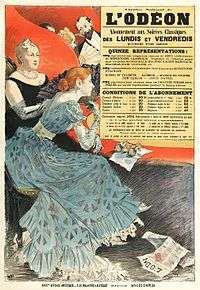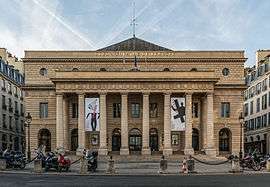Odéon-Théâtre de l'Europe
- For other theatres with this name, see Odeon
Coordinates: 48°50′58.2″N 2°20′19.5″E / 48.849500°N 2.338750°E
|
Théâtre-Français du Faubourg Saint-Germain (1782-1789) Théâtre de la Nation (1789-1793) Théâtre de l'Égalité (1794-1796) Théâtre de l'Impératrice et Reine (1808-1818) Second Théâtre-Français (1819-1990) | |
|
Facade of the Odéon-Théâtre de l'Europe | |
| Address |
2 rue Corneille, 6th arrondissement of Paris Paris |
|---|---|
| Capacity | 800 |
| Construction | |
| Opened | 1782 |
| Reopened | 1808 |
| Rebuilt | 1819 |
| Architect | Pierre Thomas Baraguay |
| Website | |
| www.theatre-odeon.fr | |
The Odéon-Théâtre de l'Europe (formerly the Théâtre de l'Odéon) is one of France's six national theatres.
It is located at 2 rue Corneille in the 6th arrondissement of Paris on the left bank of the Seine, next to the Luxembourg Garden. It was originally built between 1779 and 1782, in the garden of the former Hôtel de Condé, to a Neoclassical design by Charles De Wailly and Marie-Joseph Peyre. The Odéon was originally intended to house the Comédie Française, which, however, preferred to stay at the Théâtre-Français in the Palais Royal. The new theatre was inaugurated by Marie-Antoinette on April 9, 1782.[1] It was there that Beaumarchais' play The Marriage of Figaro was premiered two years later.
An 1808 reconstruction of the theater designed by Jean Chalgrin (architect of the Arc de Triomphe) was officially named the Théâtre de l'Impératrice, but everyone still called it the Odéon.[2] It burned in 1818.
The third and present structure, designed by Pierre Thomas Baraguay, was opened in September 1819. In 1990, the theater was given the sobriquet 'Théâtre de l'Europe'. It is a member theater of the Union of the Theatres of Europe.

Access
| Located near the Métro station: Odéon. |
References
- Notes
- ↑ Culture & History of Odéon Théâtre de l'Europe
- ↑ Regarding the name Théâtre de l'Impératrice, see Hemmings 1994, p. 106.
- Sources
- Hemmings, F. W. J. (1994). Theatre and State in France, 1760–1905. New York: Cambridge University Press. ISBN 978-0-521-03472-2 (2006 reprint).
External links
| Wikimedia Commons has media related to Théâtre de l'Odéon. |
